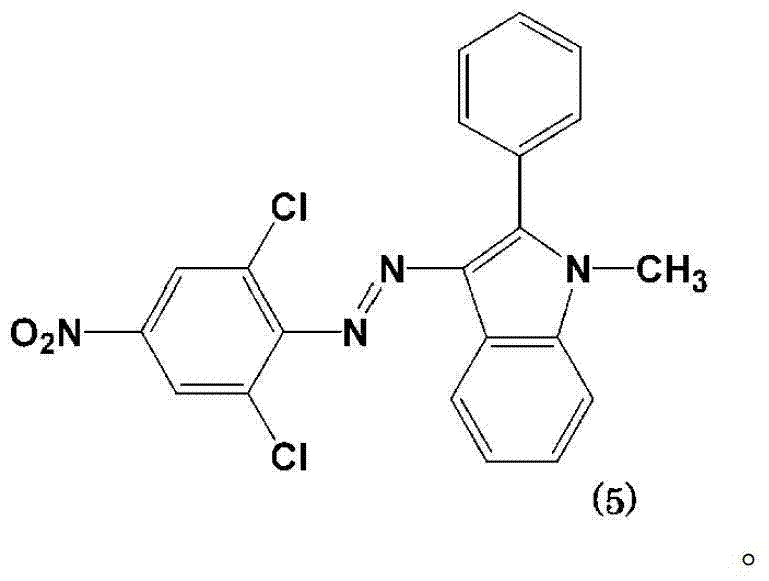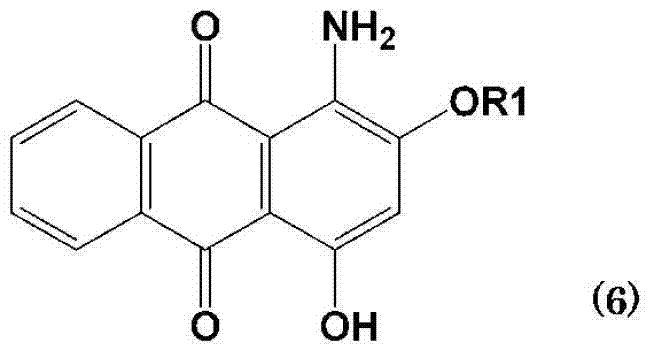Disperse dye and method for dyeing hydrophobic fiber material using same
A hydrophobic fiber and disperse dye technology, applied in the field of dye composition, can solve the problems of fading, difference in dyeing repeatability of synthetic fiber materials, unbalanced dyeing characteristics, etc., and achieve the effect of high light fastness
- Summary
- Abstract
- Description
- Claims
- Application Information
AI Technical Summary
Problems solved by technology
Method used
Image
Examples
Embodiment 1
[0077] Embodiment 1: the manufacture of disperse dye composition
[0078] To 10.2% of the raw material powder represented by the formula (1), 10.0% of the raw material powder represented by the formula (2), 13.1% of the raw material powder represented by the formula (3) and 5.6% of the raw material powder represented by the formula (5) The raw material powder was added with a dispersant in an amount of 61.1%, and then pulverized to produce a yellow-based disperse dye composition.
[0079] To 24.5% of the raw material powder represented by the formula (6-1), 10.3% of the raw material powder represented by the formula (6-2), and 7.5% of the raw material powder represented by the formula (6-3) in an amount of 57.7% dispersant, which is then pulverized to produce a red-based disperse dye composition.
[0080] A dispersant in an amount of 67.9% was added to 12.8% of the raw material powder represented by the formula (7-1) and 19.3% of the raw material powder represented by the for...
Embodiment 2
[0081] Embodiment 2: the manufacture of disperse dye composition
[0082] To 10.2% of the raw material powder represented by the formula (1), 10.0% of the raw material powder represented by the formula (2), 8.6% of the raw material powder represented by the formula (4) and 5.6% of the raw material powder represented by the formula (5) The raw material powder was added with a dispersant in an amount of 65.6%, and then pulverized to produce a yellow-based disperse dye composition.
[0083] To 24.5% of the raw material powder represented by the formula (6-1), 10.3% of the raw material powder represented by the formula (6-2), and 7.5% of the raw material powder represented by the formula (6-3) in an amount of 57.7% dispersant, which is then pulverized to produce a red-based disperse dye composition.
[0084] A dispersant in an amount of 67.9% was added to 12.8% of the raw material powder represented by the formula (7-1) and 19.3% of the raw material powder represented by the form...
Embodiment 3
[0086]In pure water, the yellow disperse dye composition of 0.607% o.w.f. (based on fiber weight), the red disperse dye composition of 0.204% o.w.f. and the blue disperse dye composition of 0.260% o.w.f. Acetic acid and sodium acetate were adjusted to pH 4.5, and 2.0% o.w.f. of an ultraviolet absorber (SUNLIFE LPX-50, manufactured by Nicca Chemical Co., Ltd.) was added thereto to prepare 2000 parts of a dyeing bath. In a dyeing bath, soak 100 parts polyester fleece fabric (use 0.3 denier yarn on the front side and 3 denier yarn on the back side) and dye at 135°C for 30 minutes. The dyed article was then prepared in a bath consisting of 6 parts of 45% caustic soda, 6 parts of bisulfite, 3 parts of Sunmol RC-700 (anionic surfactant manufactured by Nicca Chemical Co., Ltd.) and adding water In a bath of a total amount of 3000 parts, reduction cleaning was performed at 80° C. for 10 minutes, washed with water, and then dried to produce a beige-dyed article. The dyed article thus ...
PUM
 Login to view more
Login to view more Abstract
Description
Claims
Application Information
 Login to view more
Login to view more - R&D Engineer
- R&D Manager
- IP Professional
- Industry Leading Data Capabilities
- Powerful AI technology
- Patent DNA Extraction
Browse by: Latest US Patents, China's latest patents, Technical Efficacy Thesaurus, Application Domain, Technology Topic.
© 2024 PatSnap. All rights reserved.Legal|Privacy policy|Modern Slavery Act Transparency Statement|Sitemap



